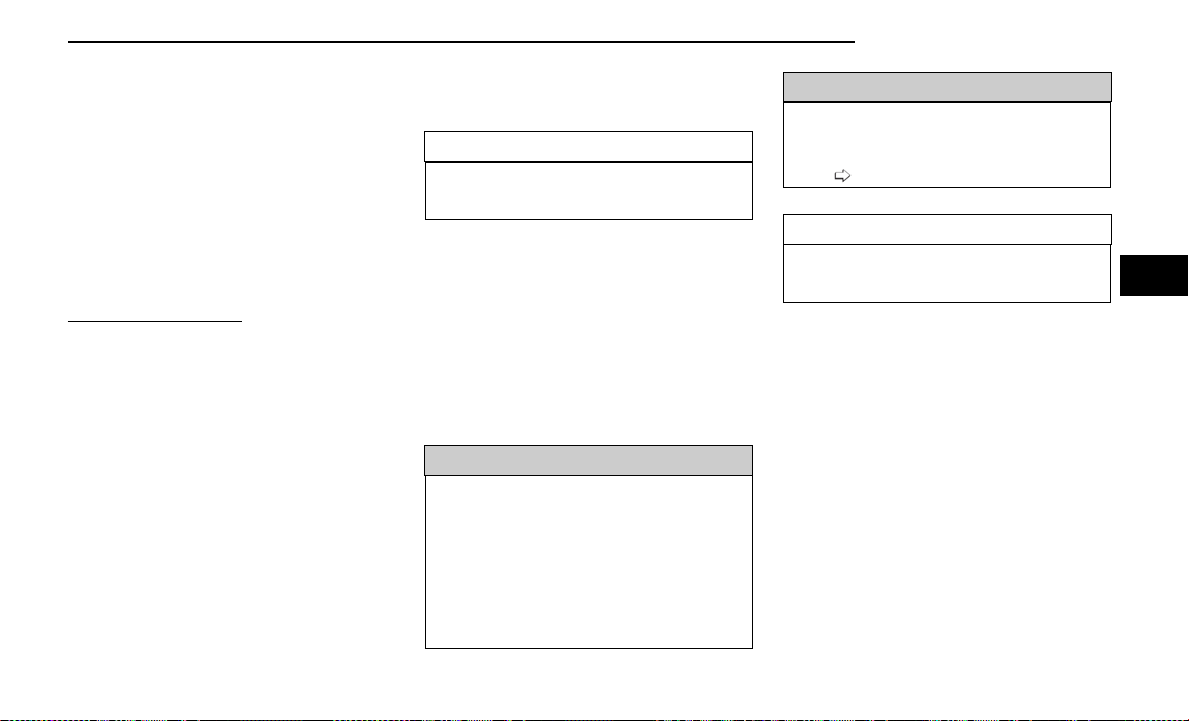Loading ...
Loading ...
Loading ...

4WD LOW — If Equipped
AutoPark will be disabled when operating the vehicle
in 4WD LOW.
The message “ AutoPark Disabled” will be displayed in
the instrument cluster.
Additional customer warnings will be given when both
of these conditions are met:
•
Vehicle is not in PARK
•
Driver’s door is ajar
The message “ AutoPark Not Engaged” will be dis-
played in the instrument cluster. A warning chime will
continue until you shift the vehicle into PARK or the
driver’s door is closed.
ALWAYS DO A VISUAL CHECK that your vehicle is in
PARK by looking for the "P" in the instrument cluster
display and on the gear selector. As an added precau-
tion, always apply the parking brake when exiting the
vehicle.
EXTENDED PARK STARTING
NOTE:
Extended Park condition occurs when the vehicle has
not been started or driven for at least 30 days.
1. Install a battery charger or jumper cables to the bat-
tery to ensure a full battery charge during the crank
cycle.
2. Press and hold the brake pedal while pushing the
ENGINE START/STOP button once.
3. If the engine fails to start within 10 seconds, wait
10 to 15 seconds to allow the starter to cool, then
repeat the Extended Park Starting procedure.
4. If the engine fails to start after eight attempts, allow
the starter to cool for at least 10 minutes, then
repeat the Extended Park Starting procedure.
CAUTION!
To prevent damage to the starter, do not crank con-
tinuously for more than 10 seconds at a time. Wait
10 to 15 seconds before trying again.
IF ENGINE FAILS TO START
If the engine fails to start after you have followed the “Nor-
mal Starting” procedure and has not experienced an
extended park condition as defined previously, it may be
flooded. Push the accelerator pedal all the way to the floor
and hold it there while the engine is cranking. This should
clear any excess fuel in case the engine is flooded. The
starter motor will engage automatically, run for 10 sec-
onds, and then disengage. Once this occurs, release the
accelerator pedal and the brake pedal, wait 10 to 15 sec-
onds, then repeat the “Normal Starting” procedure.
WARNING!
•
Never pour fuel or other flammable liquid into the
throttle body air inlet opening in an attempt to
start the vehicle. This could result in flash fire
causing serious personal injury.
•
Do not attempt to push or tow your vehicle to get it
started. Vehicles equipped with an automatic
transmission cannot be started this way. Unburned
fuel could enter the catalytic converter and once
the engine has started, ignite and damage the con-
verter and vehicle.
(Continued)
WARNING!
•
If the vehicle has a discharged battery, booster
cables may be used to obtain a start from a
booster battery or the battery in another vehicle.
This type of start can be dangerous if done improp-
erly
page 283.
CAUTION!
To prevent damage to the starter, do not continuously
crank the engine for more than 10 seconds at a time.
Wait 10 to 15 seconds before trying again.
COLD WEATHER OPERATION
(BELOW –22°F OR −30°C)
To ensure reliable starting at these temperatures, use
of an externally powered electric engine block heater
(available from an authorized dealer) is recommended.
AFTER STARTING
The idle speed is controlled automatically, and it will
decrease as the engine warms up.
TURBOCHARGER “COOL DOWN” —
3.0L ENGINE ONLY
The 3.0L engine is equipped with an after-run pump to
cool the turbocharger after the engine is shut off. Depend-
ing on the type of driving and the amount of cargo, the
pump will run for up to 20 minutes after the engine has
been shut off to circulate coolant through the turbo-
charger. Although the pump is rubber-mounted for quiet
operation, it is normal to hear it running during this time.
STARTING AND OPERATING 115
4
Loading ...
Loading ...
Loading ...